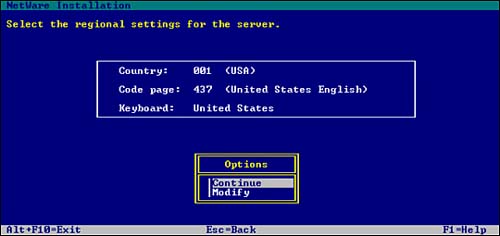Phase I: Choosing the Correct NetWare 6 Settings
| In Phase I, you will prepare the server, execute the INSTALL.BAT file, accept the license agreements, and load the core NetWare operating system. Then, you will select a plethora of general NetWare 6 settings, including upgrade type, server settings, and regional settings. Let's get started. Step 1: Prepare the ServerBefore you do anything, you must back up all the data from your source upgrade computer to an offline storage media. Also, make sure that you install the latest NetWare service pack. Refer to the "Before You Begin" section earlier for more information. NetWare 6 can be upgraded from the server's local CD drive or from upgrade files located elsewhere on the network. To access the NetWare 6 upgrade files, perform these steps:
Step 2: Begin the UpgradeTo begin the NetWare 6 upgrade process, insert the NetWare 6 Operating System CD into the CD drive (or log into the network if you have stored the NetWare 6 upgrade files on an existing server), and enter the following command at the prompt: INSTALL
Notice that the upgrade program displays the initial screens in text mode. Autodetected and/or default settings appear on each screen. You can either accept the autodetected and default settings or modify them to meet your requirements. To navigate a text screen, use the arrow keys on your keyboard. To select a menu choice, highlight the desired option and press Enter. To toggle between predetermined values in a field, highlight the field, and then press Enter to toggle to the next value. See the bottom of each screen for further information. At the beginning of the upgrade process, you are asked to agree to the terms and conditions contained in the NetWare 6 Novell Software License Agreement. Press F10 or select Accept License Agreement, as appropriate, to indicate that you have read the agreement and accept its terms and conditions. (The appropriate choice will depend on the method you used to start the upgrade program.) The upgrade program then checks the server's first hard disk to verify that it has a valid boot partition and adequate disk space. When a screen appears indicating that a valid boot partition has been found, select Continue with Existing Partition. When the JReport Runtime License Agreement screen appears, press F10 to indicate that you have read the agreement and accept its terms and conditions. Step 3: Select the Upgrade TypeWhen the "Welcome to the NetWare Server Installation" screen appears, you are given the opportunity to select the installation type (Express or Custom) and the installation method (New Server, Upgrade, or Pre-Migration). The default installation type is Express and the default installation method is Upgrade. Let's take a closer look at each of these options. The NetWare 6 installation methods available on the screen include
Review the values listed on this screen and modify them as necessary. In Lab Exercise 2.1, you will perform a NetWare 6 custom upgrade. Step 4: Specify the Server SettingsThe Server Settings screen appears next, listing the following default values:
Some information you might want to keep in mind regarding these options includes
Step 5: Select the Regional SettingsThe Regional Settings screen appears next, as shown in Figure 2.11. Regional settings are used to customize server language and keyboard settings. If you are located in the United States, the default values are as follows:
Figure 2.11. Selecting regional settings during NetWare 6 upgrade.
The upgrade program then copies a number of server boot files from the CD to the C:\NWSERVER startup directory. These include files such as SERVER.EXE, disk drivers, NWCONFIG.NLM, NWSNUT.NLM, VREPAIR.NLM, and other NetWare Loadable Modules (NLMs). This completes the first five steps of NetWare 6 upgrade, and Phase I. Now, we will continue with platform support and NetWare storage. |
EAN: 2147483647
Pages: 128
- Integration Strategies and Tactics for Information Technology Governance
- Linking the IT Balanced Scorecard to the Business Objectives at a Major Canadian Financial Group
- Technical Issues Related to IT Governance Tactics: Product Metrics, Measurements and Process Control
- Governance in IT Outsourcing Partnerships
- Governance Structures for IT in the Health Care Industry
